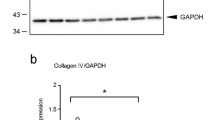Abstract
Background
Although exercise is believed to reduce the risk of rupture of the myotendinous junction, exercise-induced structural changes in this region have not been studied. We examined exercise-induced ultrastructural changes in the myotendinous junction of the lower legs in rats.
Methods
Ten adult male LETO rats were used. Five rats were randomly placed in the Exercise group; the remaining five were used as controls and placed in the non-Exercise group. Running exercise was performed every day for 4 weeks. The tibialis anterior and gastrocnemius muscles were then removed from both legs from each animal in the two groups. The specimens were subsequently examined by transmission electron microscopy (TEM). Numerous finger-like processes were observed at the myotendinous junction. The changes in frequency of branching of the finger-like process (the number of times one finger-like process branched) and the direction of the processes (the angle of the major axis of a finger-like process to the longitudinal direction of the muscle fiber) were studied. To evaluate the two indicators above, each 10 fingerlike process was randomly and separately selected from the tibialis anterior and gastrocnemius muscles of rats, providing 50 finger-like processes of both muscles for evaluation per group.
Results
In terms of the frequency of branching of the fingerlike processes, the mean values obtained in the non-Exercise group were 0.04 and 0.18 times, respectively, in the tibialis anterior and gastrocnemius muscles and were 0.38 and 1.16 times, respectively, in these two muscles in the Exercise group. Regarding the direction of the finger-like processes, the values were 4.1° and 3.6°, respectively in the non-Exercise group and 10.4° and 14.5°, respectively in the Exercise group. The differences between the two animal groups were significant.
Conclusions
Morphological changes in the myotendinous junction occurred as an adaptation to tension increased by exercise.
Similar content being viewed by others
References
Nakao T. Fine structure of the myotendinous junction and “terminal coupling” in the skeletal muscle of the lamprey, Lampetra japonica. Anat Rec 1975;182:321–338.
Nakao T. Some observations on the fine structure of the myotendinous junction in myotomal muscles of the tadpole tail. Cell Tissue Res 1976;166:241–254.
Ajiri T, Kiumra T, Ito R, Inokuchi S. Microfibrils in the myotendon junctions. Acta Anat 1978;102:433–439.
Ishikawa H. The fine structure of myo-tendon junction in some mammalian skeletal muscles. Arch Histol Jpn 1965;25:275–296.
Trotter JA, Samora A, Baca J. Three-dimensional structure of the murine muscle-tendon junction. Anat Rec 1985;213:16–25.
Ilizarov GA. The tension-stress effect on the genesis and growth of tissues. Part I. The influence of stability of fixation and soft-tissue preservation. Clin Orthop 1989;238:249–281.
Tamai K, Kurokawa T. In situ observation of adjustment of sarcomere length in skeletal muscle under sustained stretch. J Jpn Orthop Assoc 1989;63:1558–1563.
Sun JS, Hou SM, Liu TK, Lu KS. Analysis of neogenesis in rabbit skeletal muscles after chronic traction. Histol Histopathol 1994;9:699–703.
Sun JS, Hou SM, Hang YS, Liu TK, Lu KS. Ultrastructural studies on myofibrillogenesis and neogenesis of skeletal muscles after prolonged traction in rabbits. Histol Histopathol 1996;11:285–292.
Terazawa T. Ultrastructural changes of the myotendinous junction during experimental leg lengthening. J Nagoya City Univ Med Assoc 2001;52:213–221 (in Japanese).
Järvinen TA, Józsa L, Kannus P, Järvinen TL, Hurme T, Krist M, et al. Mechanical loading regulates the expression of tenascin-C in the myotendinous junction and tendon but does not induce de novo synthesis in the skeletal muscle. J Cell Sci 2003;116:857–866.
Kvist M, Hurme T, Kannus P, Järvinen T, Maunu VM, Jozsa L, et al. Vascular density at the myotendinous junction of the rat gastrocnemius muscle after immobilization and remobilization. Am J Sports Med 1995;23:359–364.
Luft JH. Improvements in epoxy resin embedding methods. J Biophys Biochem Cytol 1961;9:409–4.
Caulfield JB. Effects of varying the vehicle for OsO4 in tissue fixation. J Biophys Biochem Cytol 1957;3:827–830.
Kannus P, Jozsa L, Kvist M, Lehto M, Järvinen M. The effect of immobilization on myotendinous junction: an ultrastructural, histochemical and immunohistochemical study. Acta Physiol Scand 1992;144:387–394.
Rohen JW. Scanning electron microscopic studies of the zonular apparatus in human and monkey eyes. Invest Ophthalmol Vis Sci 1979;18:133–144.
Dudley GA, Abraham WM, Terjung RL. Influence of exercise intensity and duration on biochemical adaptations in skeletal muscle. J Appl Physiol 1982;53:844–850.
Author information
Authors and Affiliations
About this article
Cite this article
Kojima, H., Sakuma, E., Mabuchi, Y. et al. Ultrastructural changes at the myotendinous junction induced by exercise. J Orthop Sci 13, 233–239 (2008). https://doi.org/10.1007/s00776-008-1211-0
Received:
Accepted:
Published:
Issue Date:
DOI: https://doi.org/10.1007/s00776-008-1211-0




